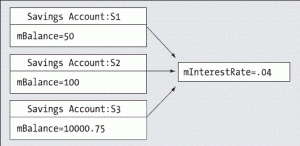A type may define static data. When a class defines nonstatic data, each object of this type maintains a private copy of the field. For example, assume a class that models a savings account:
// This class has a single piece of nonstatic data.
class SavingsAccount
{
public double currentBalance;
public SavingsAccount(double balance)
{ currentBalance = balance;}}
When you create SavingsAccount objects, memory for the currentBalance field is allocated for each instance. Static data, on the other hand, is allocated once and shared among all object instances of the same type. To illustrate the usefulness of static data, add a piece of static data named interestRate to the SavingsAccount class:
class SavingsAccount
{
public double currentBalance;
public static double interestRate = 0.04;
public SavingsAccount(double balance)
{ currentBalance = balance;}}
If you were to create three instances of SavingsAccount as so:
static void Main(string[] args)
{
// Each SavingsAccount object maintains a copy of the currBalance field.
SavingsAccount s1 = new SavingsAccount(50);
SavingsAccount s2 = new SavingsAccount(100);
SavingsAccount s3 = new SavingsAccount(10000.75);
}
the in-memory data allocation would look something like the figure.

Let's update the SavingsAccount class to define two static methods to get and set the interest rate value. As stated, static methods can operate only on static data. However, a nonstatic method can make use of both static and nonstatic data. This should make sense, given that static data is available to all instances of the type. Given this, let's also add two instance-level methods to interact with the interest rate variable:
class SavingsAccount
{
public double currentBalance;
public static double interestRate = 0.04;
public SavingsAccount(double balance)
{ currentBalance = balance;}// Static methods to get/set interest rate.
public static SetInterestRate(double newRate)
{ interestRate = newRate;}public static double GetInterestRate()
{ return interestRate;}// Instance method to get/set current interest rate.
public void SetInterestRateObj(double newRate)
{ interestRate = newRate;}public double GetInterestRateObj()
{ return interestRate;}}
Now, observe the following usage and the output.
static void Main(string[] args)
{
SavingsAccount s1 = new SavingsAccount(50);
SavingsAccount s2 = new SavingsAccount(100);
// Get and set interest rate.
Console.WriteLine("Interest Rate is: {0}", s1.GetInterestRateObj());s2.SetInterestRateObj(0.08);
// Make new object, this does NOT 'reset' the interest rate.
SavingsAccount s3 = new SavingsAccount(10000.75);
Console.WriteLine("Interest Rate is: {0}", SavingsAccount.GetInterestRate());Console.ReadLine();
}
